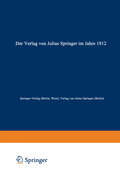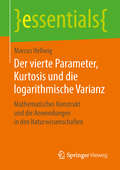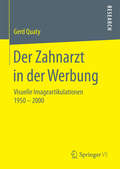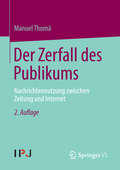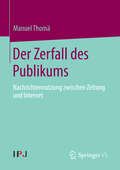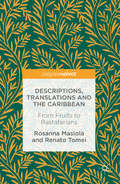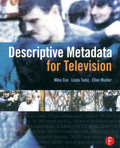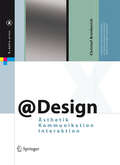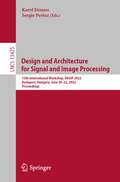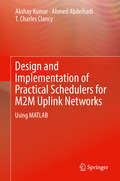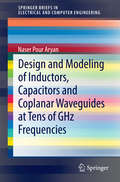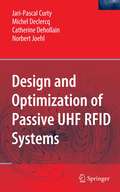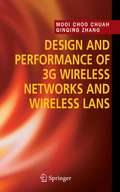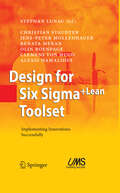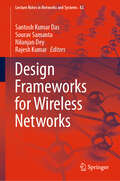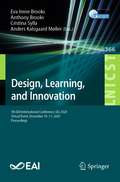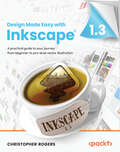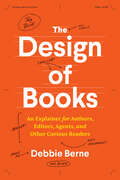- Table View
- List View
Der Verlag von Julius Springer im Jahre 1912: Ein bibliographischer Jahresbericht
by Springer-Verlag (Berlin, West) Verlag von Julius Springer (Berlin)Der verunsicherte Verbraucher: Neue Ansätze zur unternehmerischen Informationsstrategie in der Lebensmittelbranche (Gesunde Ernährung Healthy Nutrition)
by Karin BergmannDie aktuelle Kommunikationspraxis der Ernährungswirtschaft erzeugt in weiten Teilen der Bevölkerung eine erhebliche Verunsicherung. Eine wirkungsvolle unternehmerische Öffentlichkeitsarbeit in der industriellen Lebensmittelerzeugung benötigt ein neues Konzept für die Kommunikation zwischen Erzeugern, Verarbeitern, Händlern und Endverbrauchern von Lebensmitteln. Die Autorin erklärt, ohne zu pauschalisieren, was Verbraucher verunsichert und welche Konsequenzen Verbraucherverunsicherung für das Ernährungsverhalten hat. Das Buch bietet - basierend auf neuen empirischen Daten und einer repräsentativen Verbraucherbefragung - praxisbezogene Ansätze für eine neue unternehmerische Öffentlichkeitsarbeit, die darauf abzielt, mit informierten Konsumenten anstelle verunsicherter Verbraucher zu kommunizieren.
Der vierte Parameter, Kurtosis und die logarithmische Varianz: Mathematisches Konstrukt und die Anwendungen in den Naturwissenschaften (essentials)
by Marcus HellwigMarcus Hellwig zeigt auf, wie Asymmetrie die Natur und deren Gesetze beherrscht. Er diskutiert, dass nichts, das zu beobachten und zu messen ist, mit vollständig symmetrischen Eigenschaften erscheint. Die logarithmische Equibalancedistribution Eqbl als Variante der Eqb soll dort Abhilfe schaffen, wo die allgegenwärtige Gauß`sche Normalverteilung vom Grundsatz her nicht anwendbar ist. Im Gegensatz zur Log-Normalverteilung haben aber alle Parameterwerte Bestand und erhalten zusätzlich Parameter für Schiefe und Kurtosis. Der Autor belegt die Ausführungen anhand praktischer Beispiele für Anwender.Der Autor Dipl.-Ing. Marcus Hellwig war Projektleiter bei einem deutschen, international agierenden Ingenieurbüro und ist Autor einiger Bücher.
Der Wahlabend im deutschen Fernsehen: Wandel und Stabilität der Wahlberichterstattung (Forschung Kommunikation)
by Kristina WiedKristina Wied befasst sich systematisch mit der Wahlabendberichterstattung im deutschen Fernsehen. Sie liefert eine historisch-deskriptive und empirisch-analytische Analyse der Wahlabendsondersendungen von ARD, ZDF, RTL und Sat.1 zu den Bundestagswahlen 1961 bis 2002, die auf einem komplexen Mehr-Methoden-Ansatz basiert – bestehend aus einer Dokumenten- und Sekundärliteraturanalyse, qualitativen und quantitativen Inhaltsanalysen des originären Fernsehmaterials sowie Leitfadeninterviews mit Experten. Damit leistet diese Arbeit einen Beitrag zur Fernsehprogramm-, politischen Kommunikations- und Journalismusforschung: Es werden Überlegungen für eine Periodisierung der Geschichte der Wahlabendberichterstattung angestellt, Trends politischer Kommunikation werden überprüft und Entstehungszusammenhänge werden zur Erläuterung von Entwicklungsmustern im Zeitverlauf sowie von Unterschieden zwischen den Fernsehanbietern herangezogen.
Der Wandel des Fleischessens im Spiegel medialer Öffentlichkeit: Eine Diskursanalyse über kollektive Wissensbestände von der Nachkriegszeit bis heute
by Verena FingerlingSeit jeher löst Fleisch Kontroversen aus – sei es durch seine ressourcenintensive Gewinnung, die es zum Ausdruck für Wohlstand, Kraft und Gesundheit macht, oder sei es durch moralische Fragestellungen, die sich durch das Nutzen und Töten fühlender Lebewesen ergeben. Anhand des deutschen Leitmediums Der Spiegel setzt sich diese Arbeit mit Wandlungsprozessen öffentlicher Kommunikation über das Fleischessen auseinander. Für den Zeitraum der Jahre 1947 bis 2019 zeichnet sie nach, wie verschiedene Ernährungsdiskurse miteinander verschränkt sind, sich gegenseitig bedingen, befruchten und aufeinander beziehen und zeigt auf, welche Wissens- und Deutungselemente dabei zu verschiedenen Zeiten als relevant oder irrelevant in Erscheinung treten. Methodologisch basiert dies auf Konzepten der Wissenssoziologischen Diskursanalyse nach Keller und der Inhaltsanalyse nach Mayring.
Der wissenschaftliche Autor: Aspekte seiner Typologisierung am Beispiel von Einstein, Sauerbruch, Freud und Mommsen
by Elke FlatauObwohl das Schreiben von Texten ein essentieller Bestandteil seines Berufs ist, ist der Wissenschaftler bislang als Autorentyp nicht dezidiert erfasst worden. Elke Flatau definiert den wissenschaftlichen Autor ausgehend von der Funktionsweise des modernen Wissenschaftssystems und entwickelt einen Merkmalkatalog, mit dessen Hilfe sie vier prominente Fallbeispiele analysiert. Auch Berühmtheiten sind an die Regeln wissenschaftlichen Publizierens gebunden, gleichzeitig decken die Einzelstudien neuralgische Grenzmomente des Autorentyps auf. Viele der beschriebenen Gesetzmäßigkeiten bestimmen den Wissenschaftsbetrieb noch heute, werden aber durch die aktuellen medialen Umbrüche auf dem Buchmarkt in Frage gestellt.
Der Zahnarzt in der Werbung: Visuelle Imageartikulationen 1950 – 2000
by Gerd QuatyGerd Quaty rekonstruiert die Imagebildung von Zahnärzten in Deutschland von 1950 bis 2000 und zeigt darüber hinaus Tendenzen bis in die Gegenwart auf. Die Entwicklung dieses Images wird anhand von visuellen und textlichen Kommunikationsmitteln in der Werbung aufgezeigt. Der Autor legt dar, welche Elemente zum Profil des „Gottes in Weiß“ gehören und wie sie dieses Bild prägen. Seine Arbeit ist nicht nur als fachwissenschaftlicher Beitrag zur Medienpädagogik und Kommunikationswissenschaft zu sehen, sondern auch als wichtige Grundlage für die Kulturgeschichte des Ärztestandes und der Professionsgeschichte der Medizin in Deutschland seit dem Zweiten Weltkrieg.
Der Zerfall des Publikums: Nachrichtennutzung zwischen Zeitung und Internet
by Manuel ThomäE-paper, Webseite, Blog und natürlich Zeitung – Verlage vermitteln heute journalistische Informationsangebote über viele Channels. Doch wie informieren sich die Leser und User? Nur wenig ist bekannt darüber, ob für sie im Netz andere Themen Relevanz besitzen als in der Tageszeitung oder ob ein attraktiver Online-Auftritt neue Leser gewinnen und an die Zeitung heranführen kann. Manuel Thomä beschreibt, wie journalistische Informationsangebote in Printund Online-Medien genutzt werden. Er zeigt den Wandel des Nachrichtensystems zwischen Zeitung und Internet und welche Folgen er für die Medienrezeption der Leser hat. Dargestellt werden verschiedene Ansätze, die sich in der Kommunikations- und Medienforschung mit diesen Entwicklungen beschäftigen. Die empirische Basis bildet ein langjähriges Forschungsprojekt des Instituts für Praktische Journalismusforschung. Um die spezifische Nutzung einzelner Channels zu analysieren wurden 30 problemzentrierte Interviews geführt, 1.239 regelmäßige Leser telefonisch interviewt und erstmals über eine Paneluntersuchung rund 350 Leser und User periodisch online befragt. Die Ergebnisse zeigen, wie häufig und warum die befragten Leser auf einzelne Medienangebote zugreifen, wie sie diese bewerten und warum sie auf andere verzichten.
Der Zerfall des Publikums: Nachrichtennutzung zwischen Zeitung und Internet
by Manuel ThomäE-paper, Webseite, Blog und natürlich Zeitung – Verlage vermitteln heute journalistische Informationsangebote über viele Channels. Doch wie informieren sich die Leser und User? Nur wenig ist bekannt darüber, ob für sie im Netz andere Themen Relevanz besitzen als in der Tageszeitung oder ob ein attraktiver Online-Auftritt neue Leser gewinnen und an die Zeitung heranführen kann. Manuel Thomä beschreibt, wie journalistische Informationsangebote in Print- und Online-Medien genutzt werden. Er zeigt den Wandel des Nachrichtensystems zwischen Zeitung und Internet und welche Folgen er für die Medienrezeption der Leser hat. Dargestellt werden verschiedene Ansätze, die sich in der Kommunikations- und Medienforschung mit diesen Entwicklungen beschäftigen. Die empirische Basis bildet ein langjähriges Forschungsprojekt des Instituts für Praktische Journalismusforschung. Um die spezifische Nutzung einzelner Channels zu analysieren wurden 30 problemzentrierte Interviews geführt, 1.239 regelmäßige Leser telefonisch interviewt und erstmals über eine Paneluntersuchung rund 350 Leser und User periodisch online befragt. Die Ergebnisse zeigen, wie häufig und warum die befragten Leser auf einzelne Medienangebote zugreifen, wie sie diese bewerten und warum sie auf andere verzichten.
Deregulierte Telekommunikationsmärkte: Internationalisierungstendenzen, Newcomer-Dynamik, Mobilfunk- und Internetdienste (Wirtschaftswissenschaftliche Beiträge #178)
by Robert F. PelzelGrundlegende technologische und regulatorische Veränderungen haben zur Jahrtausendwende die Telekommunikationsmärkte mit erheblichem Anpassungsdruck konfrontiert. Im Mittelpunkt der hier untersuchten Problemstellung steht der Wandlungsprozeß dieses dynamischen Marktes, in dem auch eine verstärkte Ausnutzung der vorhandenen Innovationspotentiale zu beobachten ist. Dabei ist die Qualität und der Preis der Informationsübermittlung im Fest- und Mobilfunknetz zu einem determinierenden Element der Leistungsfähigkeit von Volkswirtschaften geworden. Zusätzlich verändern die technologischen Meilensteine wie Internet, E-Commerce und UMTS die "Spielregeln" für alle Marktteilnehmer in immer kürzerer Zeit. Der Vergleich der Märkte in den USA, in Großbritannien und in Deutschland zeigt dabei einige Parallelen, aber auch überraschende Unterschiede.
Descriptions, Translations and the Caribbean: From Fruits to Rastafarians
by Rosanna Masiola Renato TomeiThis book offers a new perspective on the role played by colonial descriptions and translation of Caribbean plants in representations of Caribbean culture. Through thorough examination of Caribbean phytonyms in lexicography, colonization, history, songs and translation studies, the authors argue that the Westernisation of vernacular phytonyms, while systematizing the nomenclature, blurred and erased the cultural tradition of Caribbean plants and medicinal herbs. Means of transmission and preservation of this oral culture was in the plantation songs and herb vendor songs. Musical creativity is a powerful form of resistance, as in the case of Reggae music and the rise of Rastafarians, and Bob Marley’s ‘untranslatable’ lyrics. This book will be of interest to scholars of Caribbean studies and to linguists interested in pushing the current Eurocentric boundaries of translation studies.
Descriptive Metadata for Television: An End-to-End Introduction
by Mike Cox Ellen Mulder Linda TadicDescriptive Metadata for Television is a comprehensive introduction for television professionals that need to understand metadata's purpose and technology. This easy-to-read book translates obscure technical to hands-on language understandable by real people.
Descriptive Metadata for Television: An End-to-End Introduction
by Mike Cox Ellen Mulder Linda TadicDescriptive Metadata for Television is a comprehensive introduction for television professionals that need to understand metadata's purpose and technology. This easy-to-read book translates obscure technical to hands-on language understandable by real people.
@Design: Ästhetik, Kommunikation, Interaktion (X.media.press)
by Christof BreidenichWeblogs und Web-Communities formieren sich derzeit zu Leitmedien der vernetzten Gesellschaft. Der Autor zeigt, wie deren Verständlichkeit und Handhabung erst durch Gestaltung realisiert werden. Er liefert mit Beispielen aus der Medientheorie, der Kunstwissenschaft sowie den Grundlagen der Gestaltung ein Fundament, um Kommunikation und ihre Gestaltung in interaktiven Medien zu verstehen. Kernaussagen illustriert er anhand anschaulicher Beispiele. Jeder kann zum Designer werden, wenn er versteht, wie Kommunikation in interaktiven Medien funktioniert.
Design and Architecture for Signal and Image Processing: 15th International Workshop, DASIP 2022, Budapest, Hungary, June 20–22, 2022, Proceedings (Lecture Notes in Computer Science #13425)
by Karol Desnos Sergio PertuzThis book constitutes the thoroughly refereed conference proceedings of the First International Workshop on Design and Architecture for Signal and Image Processing, DASIP 2022, held in Budaypest, Hungary in June 2022. The 13 full included in the volume were carefully reviewed and selected from 32 submissions. They are organized in the following topical sections: leading signal, image and video processing and machine learning in custom embedded, edge and cloud computing architectures and systems.
Design and Implementation of Practical Schedulers for M2M Uplink Networks: Using MATLAB
by Akshay Kumar Ahmed Abdelhadi T. Charles ClancyThis book presents the design of delay-efficient packet schedulers for heterogeneous M2M uplink traffic classified into several classes, based on packet delay requirements, payload size, arrival process, etc. Specifically, the authors use tools from queuing theory to determine the delay-optimal scheduling policy. The proposed packet schedulers are designed for a generic M2M architecture and thus equally applicable to any M2M application. Additionally, due to their low implementation complexity and excellent delay-performance, they authors show how they are also well-suited for practical M2M systems. The book pertains primarily to real-time process scheduler experts in industry/academia and graduate students whose research deals with designing Quality-of-Service-aware packet schedulers for M2M packet schedulers over existing and future cellular infrastructure. Presents queuing theoretic analysis and optimization techniques used to design proposed packet scheduling strategies;Provides utility functions to precisely model diverse delay requirements, which lends itself to formulation of utility-maximization problems for determining the delay- or utility-optimal packet scheduler;Includes detail on low implementation complexity of the proposed scheduler by using iterative and distributed optimization techniques.
Design and Implementation of Sensory Solutions for Industrial Environment: Utilizing 1-wire® Technology in Industrial Solutions (Signals and Communication Technology)
by Juraj Ďuďák Gabriel GašparThis book presents applicable guidance into sensor system hardware and software design, extensions, and integration aimed at utilization of 1-wire networks. The content is structured from the design of the sensor system architecture—hardware and software—through the implementation and optimization of the solution to the practical verification. The hardware part consists of the design of specific solutions for sensor data collection and the design and integration of standard and special sensors into these solutions. The development of the hardware solutions is focused on integration with 32-bit microcontrollers with ARM Cortex M0 to Cortex M4 cores. For the sensor solutions, the focus is on design versatility and miniaturization of dimensions with respect to the availability of the technology in the physical design. The focus is on minimizing power consumption to the design of power independent modules. The presented solution includes the design and implementation of the software layer, which includes control software for direct communication with the sensor modules as well as an information system for continuous data storage and remote access. The book presents an extensive case study that describes the design and development of a 1-wire bus controller hardware module solution with proprietary modifications that achieve improvements to the maximum 1-wire bus length. The study also includes the design and implementation of a universal and power independent 1-wire bus device. Using this module, almost any sensor can be connected to the 1-wire bus.
Design and Modeling of Inductors, Capacitors and Coplanar Waveguides at Tens of GHz Frequencies (SpringerBriefs in Electrical and Computer Engineering)
by Naser Pour AryanThis book describes the basic principles of designing and modelling inductors, MIM capacitors and coplanar waveguides at frequencies of several tens of GHz. The author explains the design and modelling of key, passive elements, such as capacitors, inductors and transmission lines that enable high frequency MEMS operating at frequencies in the orders of tens of GHz.
Design and Optimization of Passive UHF RFID Systems
by Jari-Pascal Curty Michel Declercq Catherine Dehollain Norbert JoehlRadio Frequency IDentification (RFID) stores and retrieves data using devices called RFID tags: objects attached to or incorporated into a product, animal or person which communicate with an RFID reader or interrogator. This book proposes a linear two-port model for an N-stage modified-Greinacher full wave rectifier, predicting the overall conversion efficiency at low power levels where the diodes are operating near their threshold voltage. Included is an experimental procedure to measure how impedance modulation in the tag affects the signal at the reader, and a useful tool for choosing the most appropriate impedances.
Design and Performance of 3G Wireless Networks and Wireless LANs
by Mooi Choo Chuah Qinqing ZhangPresentation of background material of wireless communications, traffic modeling and traffic engineering techniques. Provides descriptions of upcoming features such as IP multimedia subsystems, multimedia broadcast/multicast services and Push-to-Talk over Cellular (PoC) for 3G networks Including problems at the end of each chapter Written for lecturers, graduate students and system designers
Design for Six Sigma + LeanToolset: Implementing Innovations Successfully
by Christian Staudter Jens-Peter Mollenhauer Renata Meran Olin Roenpage Clemens Hugo Alexis HamalidesEvery company relies on innovation to compete globally. However, creative ideas are mostly insufficient if you want to translate an innovative spirit into commercial success. The ability to put a new product or a new process on the market as quickly as possible is becoming increasingly important. Systematic management is necessary for developing cost-effective and successful products based on market realities and customer requirements. Especially open innovation, which is currently intensively discussed and widely implemented, requires consideration. Only a sensible interface and information management is capable of generating overall success from a variety of good ideas. +Lean Design for Six Sigma is an approach for such a systematic innovation management. This concept was developed to achieve a target-oriented realization of innovations and is +Lean strongly associated with the Six Sigma methodology, currently applied globally to opti - +Lean mize existing processes. DFSS synthesizes a number of key factors, including the active integration of employees, customer-oriented development, the reduction of complexity in products and processes, and controlling of innovation in terms of a standardized procedure. The present toolset represents the proven approach UMS takes when putting Design for +Lean Six Sigma into practice. Its individual tools are assigned to the process model Define, Measure, Analyze, Design, and Verify in a clear and manageable structure. This structure can be considered as a red thread and makes it easier to apply the tools in practice and organize an innovative product and process development that is target-oriented and ef- cient.
Design Frameworks for Wireless Networks (Lecture Notes in Networks and Systems #82)
by Santosh Kumar Das Sourav Samanta Nilanjan Dey Rajesh KumarThis book provides an overview of the current state of the art in wireless networks around the globe, focusing on utilizing the latest artificial intelligence and soft computing techniques to provide design frameworks for wireless networks. These techniques play a vital role in developing a more robust algorithm suitable for the dynamic and heterogeneous environment, making the network self-managed, self-operational, and self-configurational, and efficiently reducing uncertainties and imprecise information.
Design, Learning, and Innovation: 5th EAI International Conference, DLI 2020, Virtual Event, December 10-11, 2020, Proceedings (Lecture Notes of the Institute for Computer Sciences, Social Informatics and Telecommunications Engineering #366)
by Eva Irene Brooks Anthony Brooks Cristina Sylla Anders Kalsgaard MøllerThis book constitutes the refereed post-conference proceedings the 5th EAI International Conference on DLI 2020, Design, Leaning and Innovation, which took place in December 2020. Due to COVID-19 pandemic the conference was held virtually. The 14 revised full papers presented were carefully selected from 40 submissions and are organized in four thematic sessions on: digital technologies and learning; designing for innovation; digital games, gamification and robots; designs for innovative learning.
Design Made Easy with Inkscape: A practical guide to your journey from beginner to pro-level vector illustration
by Christopher RogersWith the power and versatility of the Inkscape software, making charts, diagrams, illustrations, and UI mockups with infinite resolution becomes enjoyable. If you’re looking to get up to speed with vector illustration in no time, this comprehensive guide has got your back! Design Made Easy with Inkscape is easy to follow and teaches you everything you need to know to create graphics that you can use and reuse forever, for free! You’ll benefit from the author’s industry experience as you go over the basics of vector illustration, discovering tips and tricks for getting professional graphics done fast by leveraging Inkscape's powerful toolset. This book teaches by example, using a great variety of use cases from icons and logos to illustration, web design, and product design. You’ll learn about hotkeys and take a best-practices approach developed over ten years of using Inkscape as a design tool in production. What’s more, this book also includes links to free graphics resources that you can use in all your projects. Whether you’re a new user or a professional, by the end of this book, you’ll have full understanding of how to use Inkscape and its myriad of excellent features to make stunning graphics for your projects.Key FeaturesGet up to speed with vector illustration in no timeExplore hotkey charts and tips, with best practices developed over ten years of using InkscapeLearn the fundamentals of vector illustration and efficiently leverage Inkscape's powerful toolsetWhat you will learnUnderstand the benefits of vector illustration and the reasons behind choosing Inkscape over other non-free alternativesNavigate the Inkscape setup and workspace to make effective use of the softwareExplore the wide range of tools from Inkscape to create amazing and infinitely scalable graphics quicklyUse real-world scenarios and practice lessons to learn how to create by exampleDiscover tips and tricks to make Inkscape an extension of your creativityConvert photos to vector art and practice with professional design examples as you work with layers, shading, coloring and much moreWho this book is forThis book is for aspiring designers, developers, and anyone who wants to leverage the power of Inkscape for vector illustration. No prior knowledge of graphics applications or vector and raster graphics is required. This book simplifies Inkscape for dummies; all you need to know is how to use a mouse and keyboard.
The Design of Books: An Explainer for Authors, Editors, Agents, and Other Curious Readers (Chicago Guides to Writing, Editing, and Publishing)
by Debbie BerneSeasoned designer Debbie Berne presents an accessible introduction to book design for authors, editors, and other book people. Design is central to the appeal, messaging, and usefulness of books, but to most readers, it’s mysterious or even invisible. Through interiors as well as covers, designers provide structure and information that shape the meaning and experience of books. In The Design of Books, Debbie Berne shines a light on the conventions and processes of her profession, revealing both the aesthetic and market-driven decisions designers consider to make books readable and beautiful. In clear, unstuffy language, Berne reveals how books are put together, with discussions of production considerations, typography and fonts, page layouts, use of images and color, special issues for ebooks, and the very face of each book: the cover. The Design of Books speaks to readers and directly to books’ creators—authors, editors, and other publishing professionals—helping them to become more informed partners in the design of their projects. Berne lays out the practical steps at each stage of the design process, providing insight into who does what when and offering advice for authors on how to be effective advocates for their ideas while also letting go and trusting their manuscripts with teams of professionals. She includes guidance as well for self-publishing authors, including where to find a designer, what to expect from that relationship, and how to art direct your own book. Throughout, Berne teaches how understanding the whats, hows, and whys of book design heightens our appreciation of these cherished objects and helps everyone involved in the process to create more functional, desirable, and wonderful books.
